communication guide
Communicating supported Bluetooth® functionality
Published – 14 January 2025
1. Introduction
After successfully completing the Bluetooth® Qualification Process for a product, Bluetooth SIG members are encouraged to communicate the supported Bluetooth functionality in their product packaging and promotional materials, such as product data sheets and web pages. This guide provides recommendations for effectively communicating support for essential aspects of Bluetooth technology.
The guide aims to achieve three goals:
- Encourage consistent public communication of supported Bluetooth functionality
- Help customers easily identify Bluetooth technology and capabilities in products
- Increase customer confidence that products are up to date with the latest Bluetooth technology
It offers a framework that defines Bluetooth communication elements, preferred terminology, and usage criteria established by the Bluetooth SIG for each element. The intended audiences include members developing end-use products (e.g., mice, headphones, electronic shelf labels) and enabling technology products (e.g., chipsets, stacks, modules). The Bluetooth SIG advises members to refer to this guidance when publicly communicating supported Bluetooth functionality.
2. End-Use product guidance
This section provides guidance on communicating supported Bluetooth functionality in end-use products. It outlines the Bluetooth elements that members are encouraged to convey and offers examples of how to effectively communicate those selected elements.
2.1 Communication elements
End-use product companies are encouraged to utilize the communication elements listed below. Please note that while members often combine the Bluetooth wordmark with the Bluetooth® Core Specification against which they qualified their product (e.g., Bluetooth 5.4) to indicate support for Bluetooth technology, the SIG does not endorse this, as it may lead to incorrect assumptions about supported Bluetooth functionality.
| Communication elements Standardized terminology recommended for promotional use. | Communication criteria Indicates the product has completed the Bluetooth® Qualification Process and includes: | |
| Bluetooth® technology For general communication of Bluetooth® technology support. | Bluetooth®1 | = No criteria beyond qualification |
| Bluetooth® applications2 For communicating specific Bluetooth® applications supported by the product. | Classic Audio LE Audio AuracastTM ESL NLC | = Layer: A2DP or HFP = Layer: TMAP or HAP = Layer: PBP3 = Layer: ESLP = Layer: ALSNLCP, BLCNLCP, BSSNLCP, DICNLCP, ENMNLCP, HINLCP, or OCSNLCP |
| Bluetooth® Core Specification4 For specifying the Bluetooth® Core version the product is qualified against (if applicable). | Bluetooth® Core 5.0 Bluetooth® Core 5.1 Bluetooth® Core 5.2 Bluetooth® Core 5.3 Bluetooth® Core 5.4 Bluetooth® Core 6.0 Bluetooth® Core 6.1 Bluetooth® Core 6.2 | = ICS: CORE 1/50 or 2/50 = ICS: CORE 1/51 or 2/51 = ICS: CORE 1/52 or 2/52 = ICS: CORE 1/53 or 2/53 = ICS: CORE 1/54 or 2/54 = ICS: CORE 1/60 or 2/60 = ICS: CORE 1/61 or 2/61 = ICS: CORE 1/62 or 2/62 |
1Per the Brand Guide for Bluetooth® Trademarks, the term “technology” should directly follow “Bluetooth®” if it is unclear that “Bluetooth®” refers to a wireless technology.
2When referring to an application outside of any Bluetooth context, use “Bluetooth®” before the name (e.g., Bluetooth® ESL).
3In addition to supporting PBP, the Auracast Trademarks have additional usage requirements outlined in the Brand Guide for Bluetooth® Trademarks.
4The Bluetooth® Core Specification should not be included in product names or used as the sole method for communicating support for Bluetooth technology.
2.2 Communication example
Below is an example of a web page showcasing a product’s technical specifications section, where Bluetooth® functionality support is typically highlighted. While formats may vary, this provides an accurate representation of how relevant communication elements should be displayed when the communication criteria for each element are met.
After reviewing the example, if your team has specific questions about communicating supported Bluetooth functionality in your products, please contact the Brand Management Team at the Bluetooth SIG.

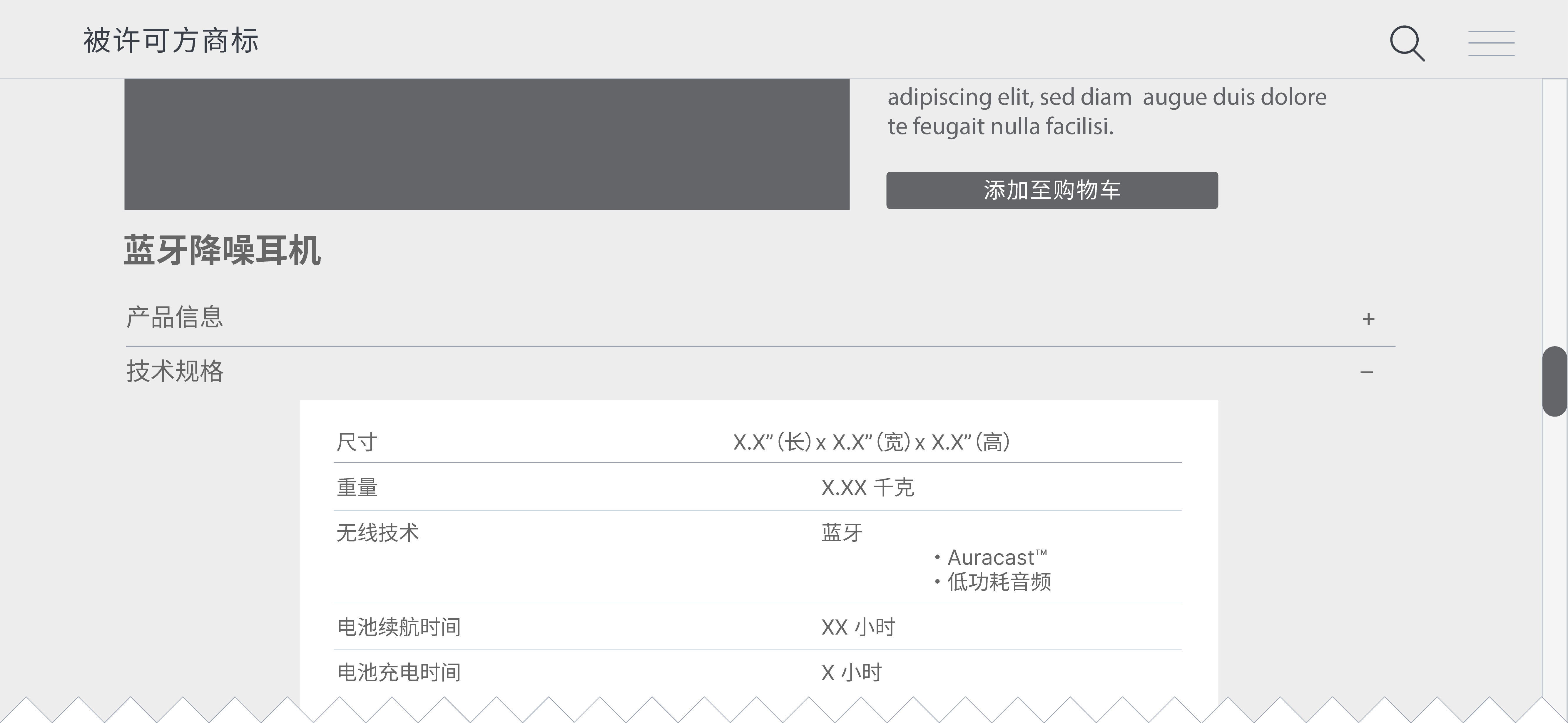

Note: If none of the Bluetooth applications listed in the communications elements table (Section 2.1) are supported, the Bluetooth SIG recommends displaying only “Bluetooth®” without additional details. The Bluetooth SIG also advises against specifying the Bluetooth® Core Specification at this communication level, as it may confuse end users. If you choose to include this information, it should be displayed as: “Qualified against Bluetooth® Core 5.4″ (for example).
2.3 Communicating future support
Members may communicate future support for Bluetooth applications listed in the communication elements table above in conjunction with qualified end-use products by using the phrase “Ready for”, provided that the member has qualified the product with Bluetooth specification support for the defined application (e.g., PBP for Auracast™), and intends to provide an update to products already in the field that are marketed as having future support. An example is provided below.
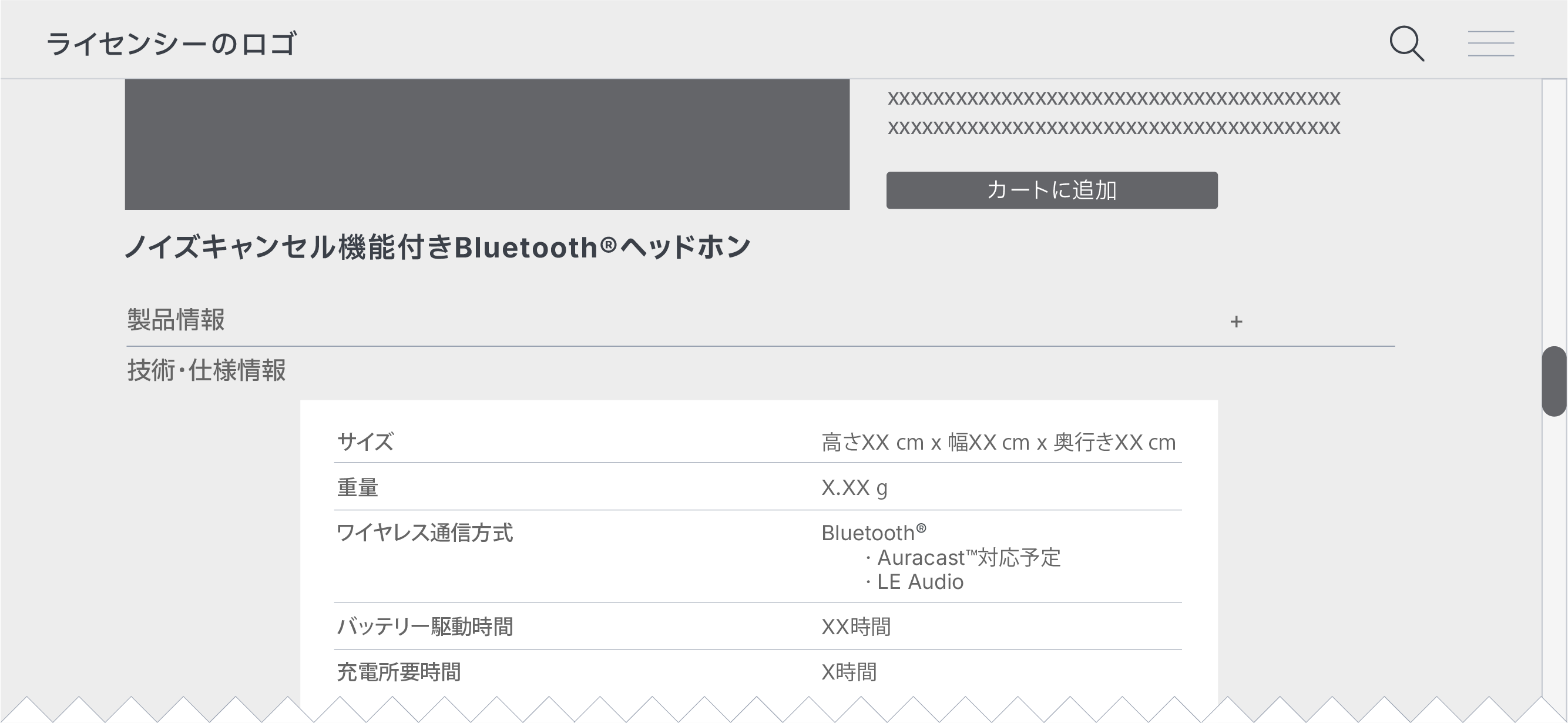
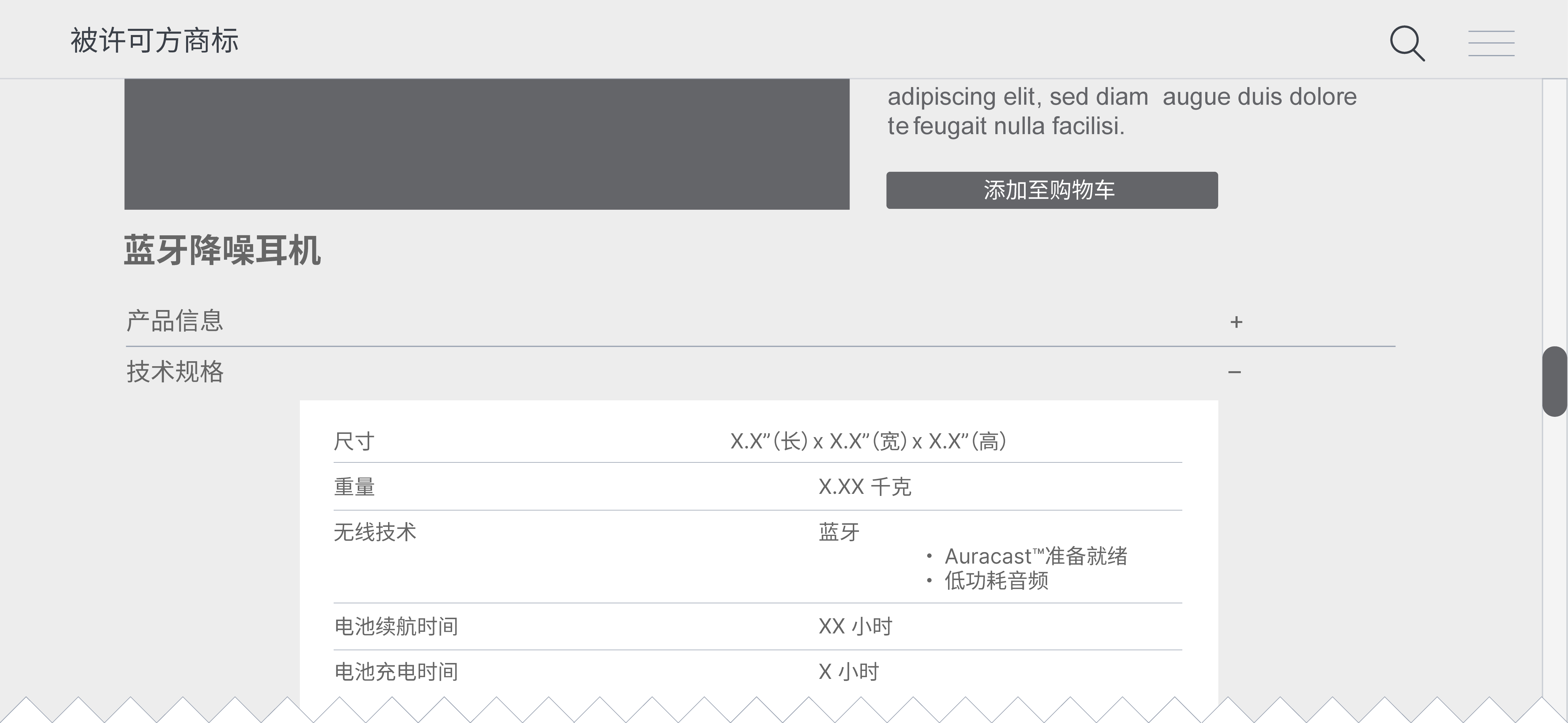

3. Enabling technology product guidance
This section provides guidance on communicating supported Bluetooth functionality in enabling technology products. It outlines the Bluetooth elements that members are encouraged to convey and offers examples of how to effectively communicate those selected elements.
3.1 Communication elements
Enabling technology product companies are encouraged to utilize the following communication elements listed below. Please note that while members often combine the Bluetooth wordmark with the Bluetooth® Core Specification against which they qualified their product (e.g., Bluetooth 6.0) to indicate support for Bluetooth technology, the SIG does not endorse this, as it may lead to incorrect assumptions about supported Bluetooth functionality.
| Communication elements Standardized terminology recommended for promotional use. | Communication criteria Indicates the product has completed the Bluetooth® Qualification Process and includes: | |
| Bluetooth® technology For general communication of Bluetooth® technology support. | Bluetooth®1 Bluetooth® Classic Bluetooth® LE Bluetooth® Dual-Mode | = No criteria beyond qualification = ICS: CORE 30/1 or 30/3 = ICS: CORE 30/2 or 30/3 = ICS: CORE 30/3 |
| Bluetooth® features2 3 For communicating specific Bluetooth® features supported by the product. | Channel Sounding LE 2M LE Coded Direction Finding LE Power Control Isochronous Channels Extended Advertising Periodic Advertising Periodic Advertising with Responses Shorter Connection Intervals LE Secure Connections Classic Audio LE Audio Mesh Networking | = ICS: CS 1/1 or 1/2 = ICS: RFPHY 1/4 = ICS: RFPHY 1/7 = ICS: RFPHY 1/9 or 1/11 = ICS: LL 9/37 = ICS: LL 9/31, 9/32, or 9/33 = ICS: LL 9/41 = ICS: LL 9/42 = ICS: LL 9/49 or 9/50 = ICS: LL 9/69 = ICS: GAP 27b/5 or 37b/5 = Layer: A2DP or HFP = Layer: BAP = Layer: MESH or MMDL |
| Bluetooth® profiles4 5 For communicating specific Bluetooth® profiles supported by the product. | Advanced Audio Distribution Profile Hands-Free Profile Telephony and Media Audio Profile Hearing Access Profile Public Broadcast Profile Ranging Profile Generic Health Sensor Profile Electronic Shelf Label Profile Ambient Light Sensor NLC Profile Basic Lightness Controller NLC Profile Basic Scene Selector NLC Profile Dimming Control NLC Profile Energy Monitor NLC Profile HVAC Integration NLC Profile Occupancy Sensor NLC Profile | = Layer: A2DP = Layer: HFP = Layer: TMAP = Layer: HAP = Layer: PBP = Layer: RAP = Layer: GHSP = Layer: ESLP = Layer: ALSNLCP = Layer: BLCNLCP = Layer: BSSNLCP = Layer: DICNLCP = Layer: ENMNLCP = Layer: HINLCP = Layer: OCSNLCP |
| Bluetooth® Core Specification6 For specifying the Bluetooth® Core version the product is qualified against (if applicable). | Bluetooth® Core 5.0 Bluetooth® Core 5.1 Bluetooth® Core 5.2 Bluetooth® Core 5.3 Bluetooth® Core 5.4 Bluetooth® Core 6.0 Bluetooth® Core 6.1 Bluetooth® Core 6.2 | = ICS: CORE 1/50 or 2/50 = ICS: CORE 1/51 or 2/51 = ICS: CORE 1/52 or 2/52 = ICS: CORE 1/53 or 2/53 = ICS: CORE 1/54 or 2/54 = ICS: CORE 1/60 or 2/60 = ICS: CORE 1/61 or 2/61 = ICS: CORE 1/62 or 2/62 |
1Per the Brand Guide for Bluetooth® Trademarks, the term “technology” should directly follow “Bluetooth®” if it is unclear that “Bluetooth®” refers to a wireless technology.
2When referring to a feature outside of any Bluetooth context, use “Bluetooth®” before the name (e.g., Bluetooth® Channel Sounding).
3This table outlines key Bluetooth features; members may also communicate additional features that have qualified support.
4When referring to a profile, it is acceptable to use the layer acronym if needed (e.g., “RAP” instead of “Ranging Profile”).
5This table outlines key Bluetooth profiles; members may also communicate additional profiles that have qualified support.
6The Bluetooth® Core Specification should not be included in product names or used as the sole method for communicating support for Bluetooth technology.
3.2 Communication example
Below is an example of a web page showcasing a product’s features section, where Bluetooth® functionality support is typically highlighted. While formats may vary, this provides an accurate representation of how all communication elements should be displayed when the communication criteria are met for each element.
After reviewing the example, if your team has specific questions about communicating supported Bluetooth functionality in your products, please contact the Brand Management Team at the Bluetooth SIG.
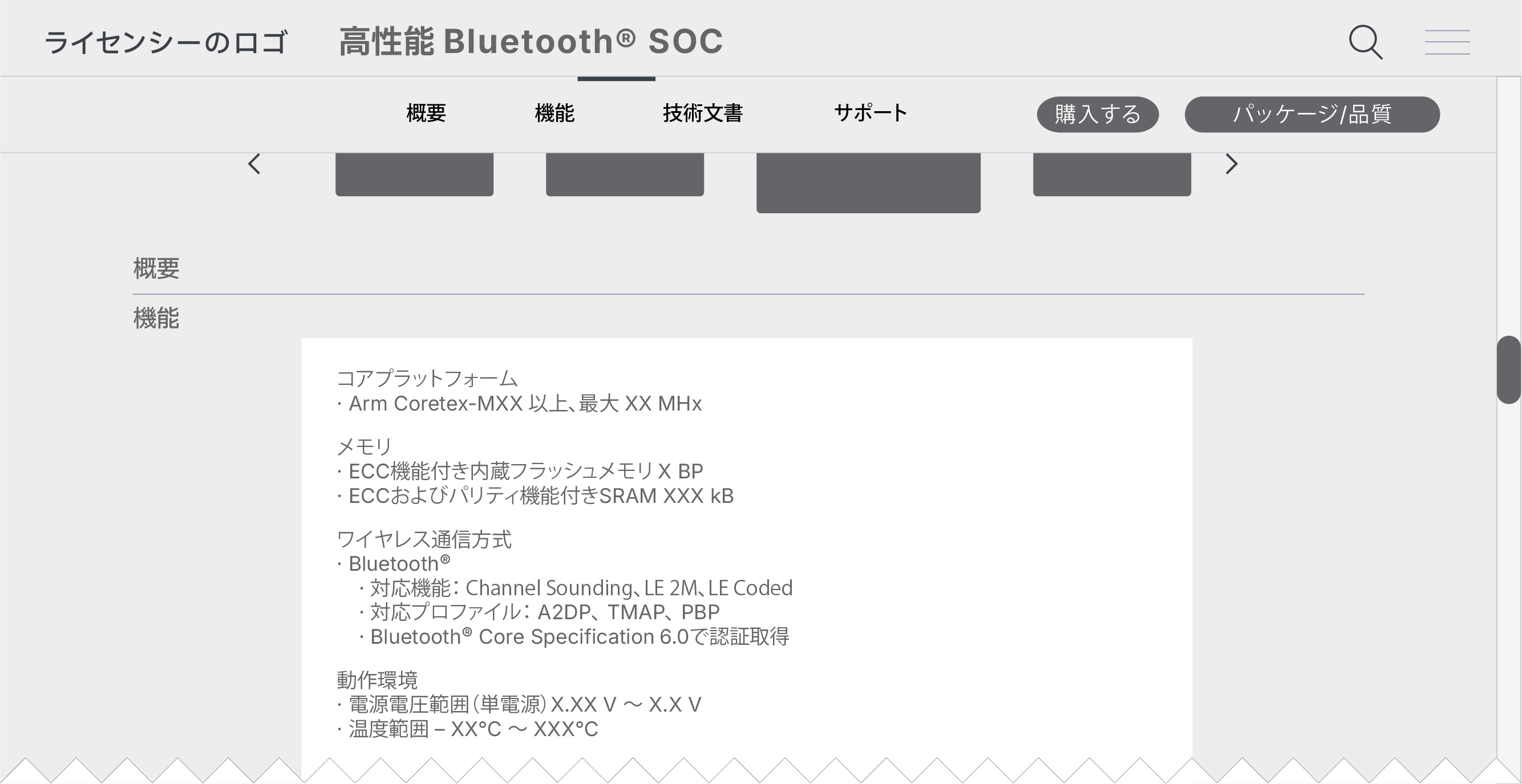
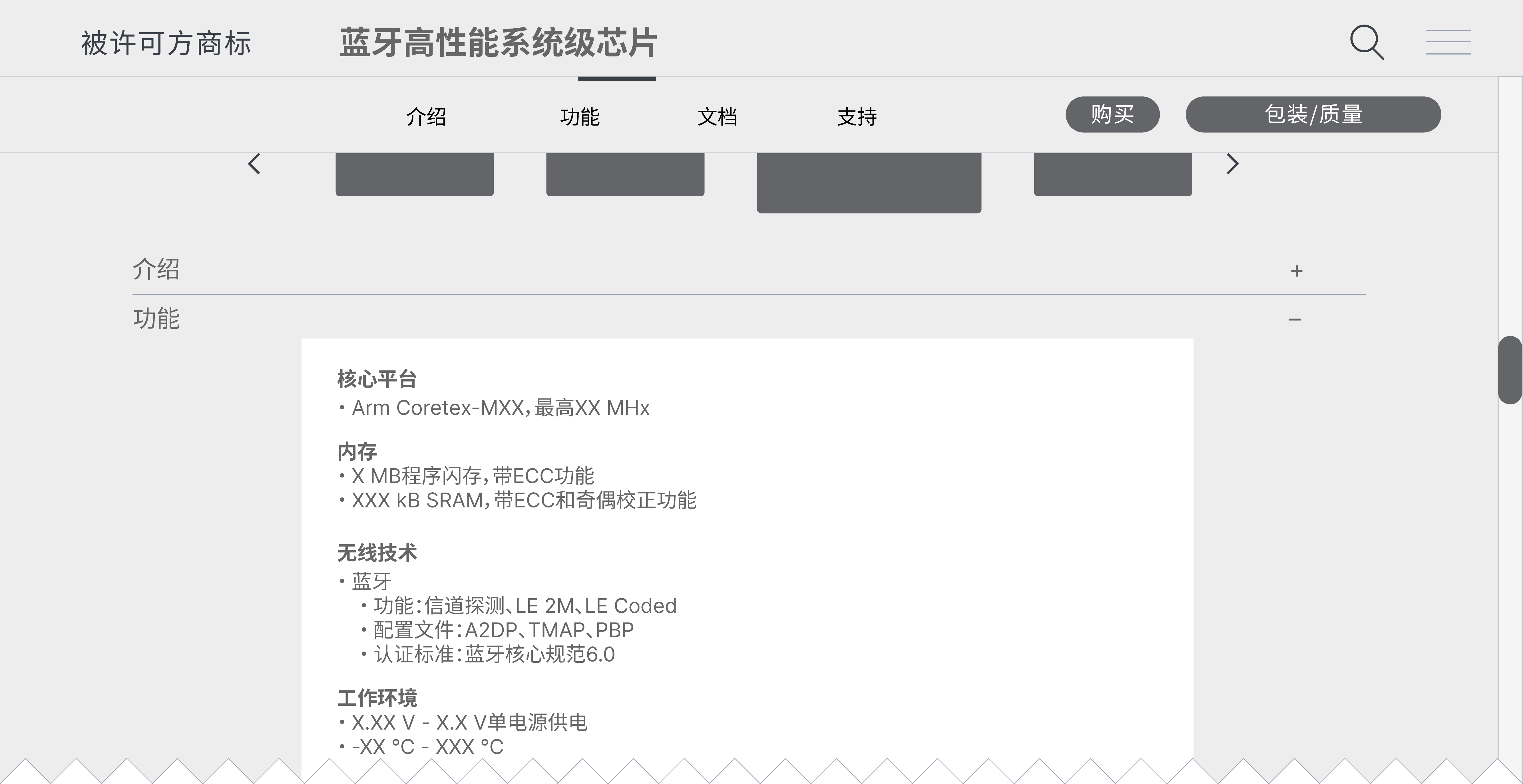
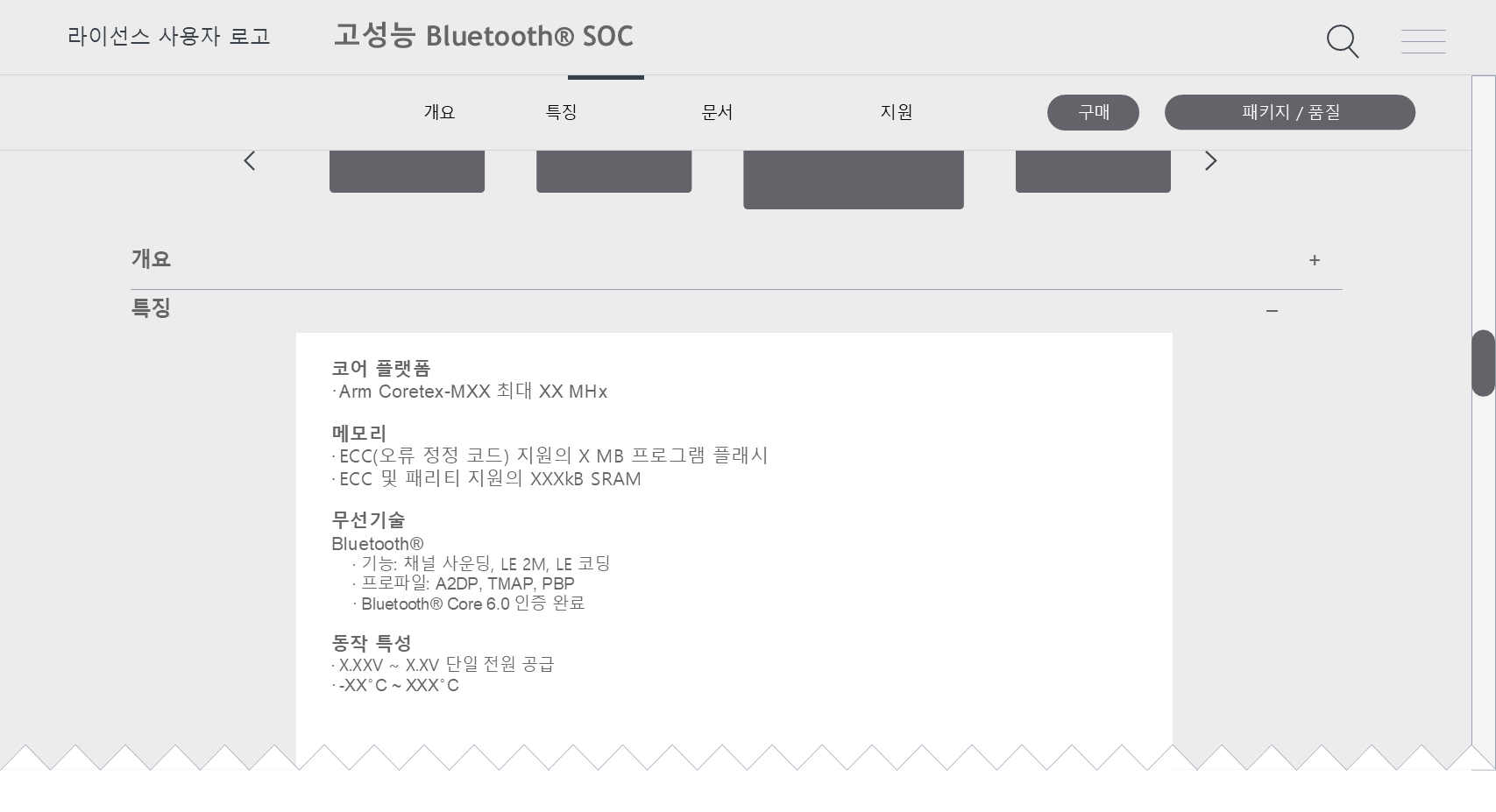
3.3 Communicating early support
The Bluetooth SIG recognizes that member companies may need to communicate support for upcoming Bluetooth functionality within qualified enabling technology products (e.g., chipsets, stacks, modules) to downstream customers to aid product planning and development efforts. Members who choose to communicate early support for pre-adopted Bluetooth features (and profiles) listed in the communication elements table above should clearly indicate “early support” and acknowledge that such support is “based on a working draft of a potential Bluetooth Specification subject to change.” An example is provided below.
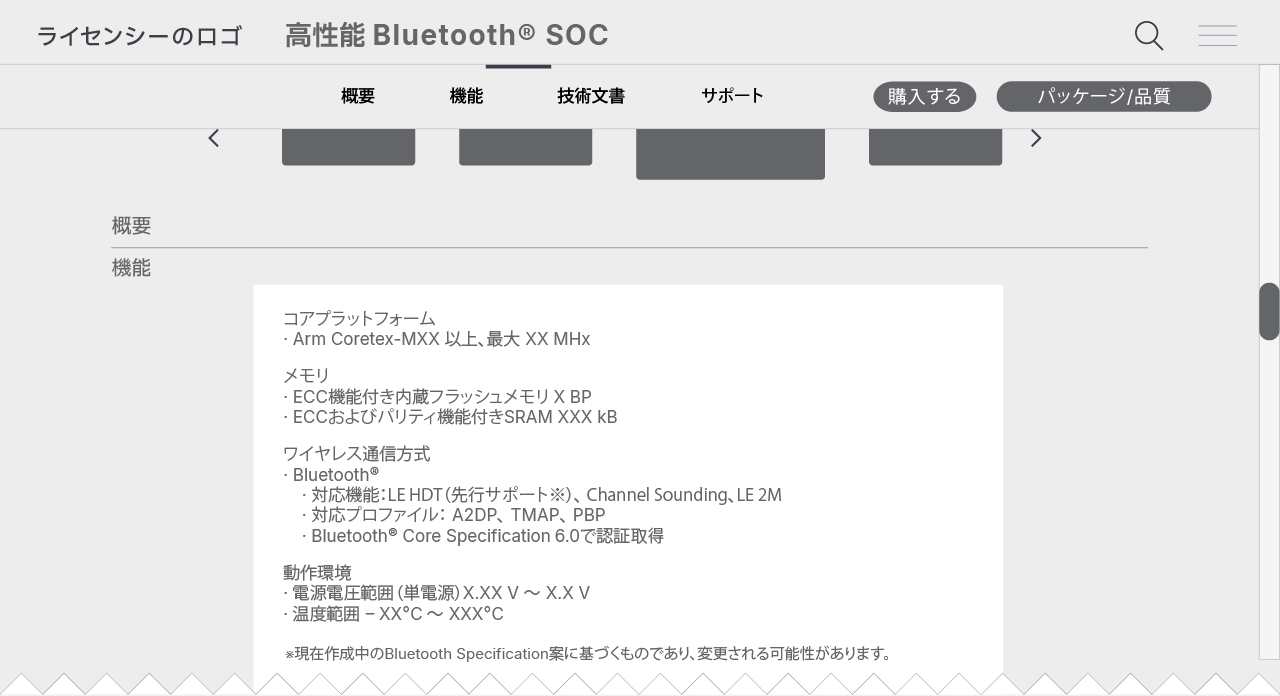
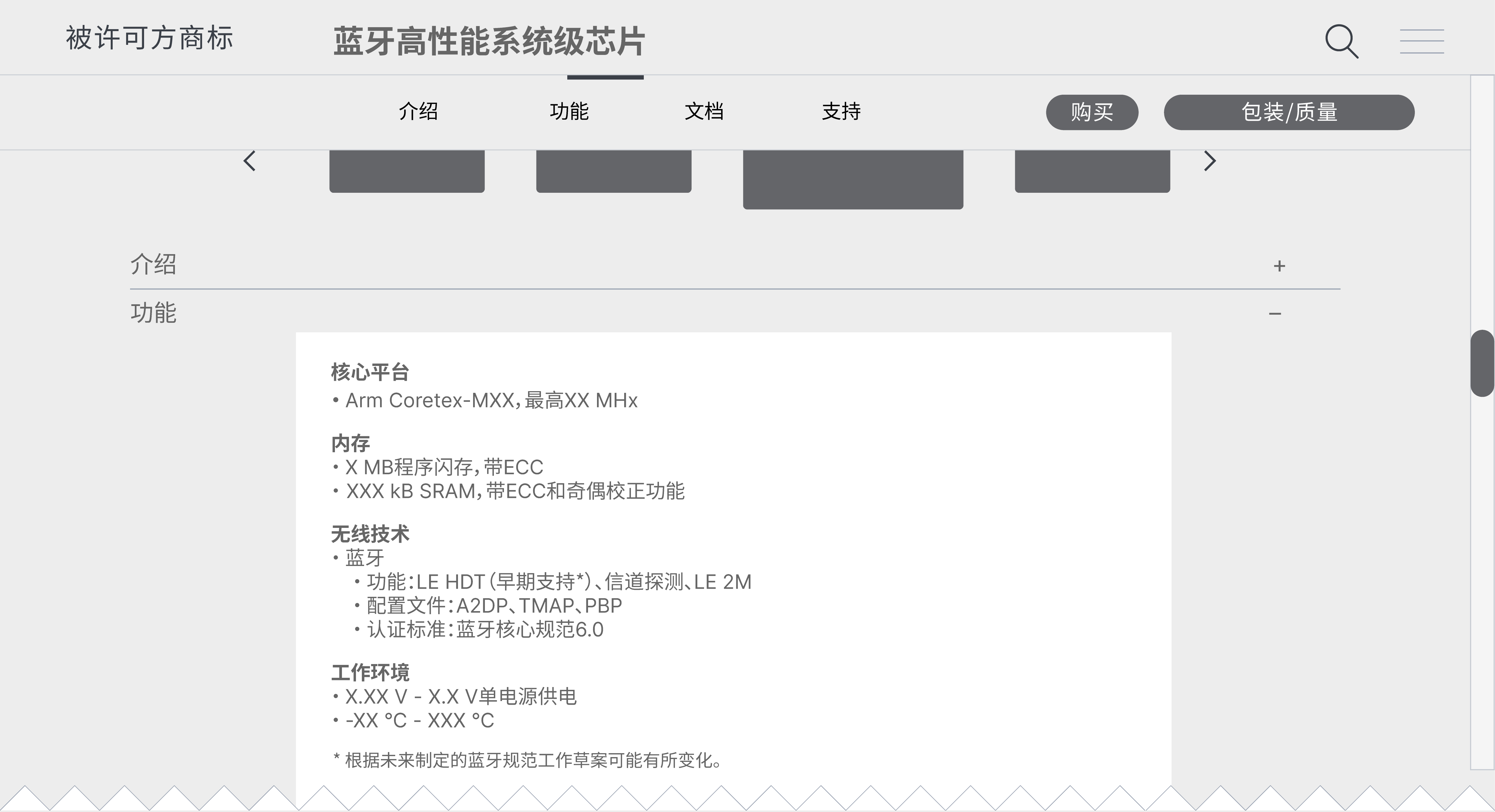

4. Appendix
This appendix provides standardized descriptions of Bluetooth® technology, applications, features, and profiles recommended for use in public-facing materials by Bluetooth SIG members. Using these descriptions promotes consistency across the Bluetooth ecosystem and helps improve customer understanding of the Bluetooth functionality supported in qualified products.
4.1 Bluetooth technology
Bluetooth®
Bluetooth® enables wireless communication between devices over short distances using the 2.4GHz ISM band. It supports various applications, including audio streaming, data transfer, device networks, positioning, and tracking. Bluetooth enables a wide range of wireless solutions, with options for very-low-power, long-range, and high-data-rate deployment scenarios.
Bluetooth® Classic
Bluetooth® Classic is a low-power radio that operates over 79 channels in the 2.4GHz ISM band. It supports point-to-point communication and is widely used for wireless audio streaming in devices like speakers, headphones, and car infotainment systems. It also supports data transfer applications.
Bluetooth® Dual-Mode
Bluetooth® Dual-Mode supports both Bluetooth® Classic and Bluetooth® LE, allowing devices to communicate with a wider range of Bluetooth enabled products. It provides flexibility for applications that require both high data rates and low power consumption, supporting various use cases from audio streaming to very-low-power large-scale device networks.
Bluetooth® LE
Bluetooth® LE is a low-power radio that operates over 40 channels in the 2.4GHz ISM band. It supports multiple communication topologies, like point-to-point, broadcast, and mesh networking. Bluetooth® LE is now also widely used for high-accuracy device positioning, enabling devices to detect presence, distance, and direction.
4.2 Bluetooth applications
Auracast™
Auracast™ broadcast audio is a new Bluetooth capability that delivers life-changing audio experiences. It enables audio sharing, unmutes the world, and enhances the way individuals engage with others and the environment.
Classic Audio
The Classic Audio standard refers to using Bluetooth Basic Rate/Enhanced Data Rate (BR/EDR) technology to enable low-power audio streams. It has become the leading global standard behind wireless smartphones, speakers, headphones, and in-car entertainment systems.
ESL
Electronic shelf label (ESL) systems have historically relied on proprietary protocols for wireless communication, which presents a potential barrier to global adoption. To address this challenge, leaders from the ESL industry teamed up with the Bluetooth SIG to create a scalable, ultra-low-power, highly secure ESL wireless standard based on Bluetooth technology.
LE Audio
LE Audio is the next generation of Bluetooth audio. It enhances Bluetooth audio’s performance, adds support for hearing aids, and introduces Auracast™ broadcast audio, which will deliver new audio experiences that enhance your engagement with others and the world around you.
NLC
Specifically designed to meet the scale, reliability, and security demands required in commercial settings, Bluetooth NLC is a full-stack standard that enables multi-vendor interoperable wireless lighting control systems and unlocks the potential for mass adoption of wireless lighting control.
4.3 Bluetooth features
Channel Sounding
Channel Sounding is a secure, fine-ranging feature that enables true distance awareness between two Bluetooth devices. It enhances the performance of applications and use cases that require highly accurate and secure device positioning, including Bluetooth “Find My,” digital keys, and more.
Direction Finding
Direction Finding enables a Bluetooth device to determine the direction of the signal from another Bluetooth device using phase angle information via angle of arrival (AoA) or angle of departure (AoD). It supports applications such as asset tracking, worker safety, and player performance.
Extended Advertising
Extended Advertising is a connectionless communication feature that adds new channels and enables devices to transmit larger amounts of data in their advertising packets. It enhances the capabilities of Bluetooth LE advertising broadcast by enabling more efficient broadcasting, improved range, and support for more complex data exchanges.
Isochronous Channels
Isochronous Channels is a feature for transmitting data with guaranteed timing and consistent intervals, ensuring low latency and predictable delivery. They are particularly useful for LE Audio use cases that require real-time data streaming, where maintaining synchronization is critical.
LE 2M
LE 2M is a Gaussian Frequency Shift Keying (GFSK) physical layer (PHY) that enables Bluetooth LE devices to achieve data rates up to 2 Mbps.
LE Audio
LE Audio is a flexible audio standard that uses the Bluetooth LE architecture for efficient, high-quality audio with lower power consumption. It enhances the performance of Bluetooth audio, adds support for hearing aids, and introduces Auracast™ broadcast audio.
LE Coded
LE Coded is a Gaussian Frequency Shift Keying (GFSK) physical layer (PHY) that enhances the range and reliability of Bluetooth LE communication by using forward error correction (FEC). This allows devices to maintain stable connections over longer distances, even in challenging RF environments.
LE Power Control
LE Power Control dynamically adjusts the transmission power of Bluetooth LE devices to optimize communication range and minimize power consumption. It helps maintain a stable connection while reducing interference and conserving battery life, especially in fluctuating signal conditions.
LE Secure Connections
LE Secure Connections enhances security by using authenticated pairing and encryption with Elliptic Curve Diffie-Hellman (ECDH) for key exchange. It protects data from eavesdropping and man-in-the-middle attacks during device communication.
Mesh Networking
Mesh Networking is a device-to-device network protocol designed for control, monitoring, and automation systems, where hundreds or even thousands of devices must communicate with one another. It is tailored to meet the stringent requirements of commercial and industrial environments, where ease of deployment, performance, and security are critical.
Periodic Advertising
Periodic Advertising allows devices to broadcast advertising packets at scheduled intervals, improving power efficiency. This feature is particularly useful for use cases like location services and asset tracking, where consistent, low-energy transmissions are needed over extended periods.
Periodic Advertising with Responses
Periodic Advertising with Responses (PAwR) is a bi-directional connectionless feature that enables devices to periodically broadcast data at scheduled intervals, improving power efficiency. It also allows devices to receive responses to their advertisements, enabling more efficient and interactive communication. PAwR enables very low-power device networks such as electronic shelf labels (ESL), electric vehicle (EV) battery management, and tire pressure monitoring.
Shorter Connection Intervals
Shorter Connection Intervals (SCI) reduce the minimum connection interval from 7.5 ms to 375 µs, enabling faster device responsiveness for high-performance HID devices, real-time HMI systems, and sensors.
4.4 Bluetooth profiles
Advanced Audio Distribution Profile
The Advanced Audio Distribution Profile enables the wireless transmission of high-quality stereo audio from a source device, like a smartphone, to a receiver, such as wireless headphones or speakers. It supports audio codecs like SBC, AAC, and aptX to ensure interoperable, reliable Bluetooth Classic audio streaming.
Ambient Light Sensor NLC Profile
The Ambient Light Sensor NLC Profile standardizes the method by which Bluetooth LE devices detect and communicate ambient light levels. This enables automatic adjustments like screen brightness or other environmental settings based on surrounding light conditions.
Basic Lightness Controller NLC Profile
The Basic Lightness Controller NLC profile standardizes the method by which Bluetooth LE devices control and adjust the lightness or brightness of compatible lighting devices based on user commands or environmental factors.
Basic Scene Selector NLC Profile
The Basic Scene Selector NLC profile standardizes the method by which Bluetooth LE devices select and activate predefined lighting scenes or configurations based on user preferences or environmental conditions.
Dimming Control NLC Profile
The Dimming Control NLC profile standardizes the method by which Bluetooth LE devices adjust the brightness of compatible lighting systems, allowing for smooth dimming or brightening based on user input or environmental factors.
Electronic Shelf Label Profile
The Electronic Shelf Label (ESL) Profile standardizes the method by which Bluetooth LE devices wirelessly control, and update price or product information displayed on electronic shelf labels in retail environments.
Energy Monitor NLC Profile
The Energy Monitor NLC Profile standardizes the method by which Bluetooth LE devices track and report energy consumption data from connected devices, helping users optimize power usage and efficiency.
Generic Health Sensor Profile
The Generic Health Sensor Profile standardizes the method by which Bluetooth LE devices collect and transmit health-related data, such as heart rate or temperature, from sensors to compatible health monitoring systems.
Hands-Free Profile
The Hands-Free Profile allows a hands-free device, like a car’s infotainment system or a wireless headset, to communicate with a smartphone. It supports features such as voice dialing, call answering, and audio routing, enabling interoperable, hands-free communication using Bluetooth Classic audio.
Hearing Access Profile
The Hearing Access Profile standardizes the method by which Bluetooth LE devices connect hearing aids or other assistive listening devices, enhancing audio accessibility for individuals with hearing impairments.
HVAC Integration NLC Profile
The HVAC Integration NLC Profile standardizes the method by which thermostats receive occupancy and environmental data from Bluetooth sensors, enhancing building automation and energy efficiency.
Occupancy Sensor NLC Profile
The Occupancy Sensor NLC Profile standardizes the method by which Bluetooth LE devices detect and report occupancy status, allowing for automated control of lighting or HVAC systems based on room occupancy.
Public Broadcast Profile
The Public Broadcast Profile standardizes the method by which Bluetooth LE devices transmit data, such as advertisements, notifications, or messages, to nearby devices in a one-to-many communication model. This facilitates information distribution without the need for pairing or direct connections and supports Auracast™ broadcast audio for enhanced audio streaming in public spaces.
Ranging Profile
The Ranging profile defines the interoperable exchange of Channel Sounding ranging data for distance calculation. It standardizes how a distance measurement application can read ranging results from a remote device, as well as how to configure the desired content, delivery method, and ranging parameters.
Telephony and Media Audio Profile
The Telephone and Media Audio Profile defines a set of configuration settings for underlying audio-related specifications to ensure seamless interoperability across a broad range of Bluetooth LE telephony and media devices. It enables consistent, high-quality conversational, streaming, and broadcast audio experiences in products such as headsets, smartphones, TVs, personal computers, wireless speakers, headphones, earbuds, and wireless microphones.